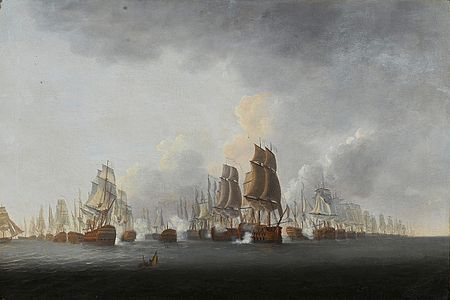William Elliott (painter) facts for kids

William Elliott was a talented artist who lived from the late 1700s to the early 1800s. He was also a lieutenant in the Royal Navy. Elliott became famous for his paintings of ships and sea battles. These types of paintings are called marine art.
Contents
Early Career as an Artist
William Elliott started showing his artwork to the public in 1774. His first known exhibitions were with the Free Society of Artists. He showed paintings like 'A Perspective View of the European Factory at Canton in China'. He also displayed 'A View of the Green, &c. at Calcutta in Bengal'. These early works showed his skill in painting detailed scenes.
Elliott became well-known for his paintings of important naval events. These were battles that happened between 1780 and 1790. He often showed his work at the Royal Academy.
Some of his famous paintings included:
- 'A Frigate and Cutter in Chase' (1784)
- 'The Fleet in Port Royal Harbour, Jamaica' (1785)
- 'View of the City of Quebec' (1786)
- 'Breaking the French Line during Lord Rodney's Action on 12 April 1782' (1787)
- 'The Fire at Kingston, Jamaica, on 8 Feb. 1782' (1788)
- 'The Action between H.M.S. Quebec and Le Surveillant' (1789)
- 'The Action between H.M.S. Serapis and Le Bonhomme' (1789)
These paintings captured exciting moments from sea history. They helped people imagine what these battles were like.
Later Life and Legacy
William Elliott was a member of the Incorporated Society of Artists. He showed many pictures at their exhibitions. In 1791, he even became the president of this society.
You can find some of his paintings in the royal collection. Two of his works showing the English fleet are at Hampton Court. Some of his art was also made into prints. For example, he created an aquatint print of 'The Dreadful Situation of the Halsewell, East Indiaman, 6 Jan. 1786'. This shows he was skilled in different art forms.
When Did He Die?
The exact year William Elliott died is not fully clear. Some records, like the Dictionary of National Biography, say he died in 1792. However, other sources suggest he lived longer. The Netherlands Institute for Art History believes he died in or after 1810. They also note that he is sometimes confused with other people named W.E. who died in different years. For example, some paintings of the Battle of Cape St. Vincent from 1797 are thought to be his work. This suggests he was still active after 1792.

